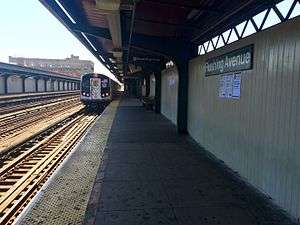Flushing Avenue (BMT Jamaica Line)
| Flushing Avenue | |||||||||||||||||||||
|---|---|---|---|---|---|---|---|---|---|---|---|---|---|---|---|---|---|---|---|---|---|
| New York City Subway rapid transit station | |||||||||||||||||||||
 | |||||||||||||||||||||
| Station statistics | |||||||||||||||||||||
| Address |
Flushing Avenue & Broadway Brooklyn, NY 11206 | ||||||||||||||||||||
| Borough | Brooklyn | ||||||||||||||||||||
| Locale | Williamsburg, Bedford-Stuyvesant, Bushwick | ||||||||||||||||||||
| Coordinates | 40°42′02″N 73°56′31″W / 40.700683°N 73.941979°WCoordinates: 40°42′02″N 73°56′31″W / 40.700683°N 73.941979°W | ||||||||||||||||||||
| Division | B (BMT) | ||||||||||||||||||||
| Line | BMT Jamaica Line | ||||||||||||||||||||
| Services |
J M | ||||||||||||||||||||
| Transit connections |
| ||||||||||||||||||||
| Structure | Elevated | ||||||||||||||||||||
| Platforms | 2 side platforms | ||||||||||||||||||||
| Tracks | 3 | ||||||||||||||||||||
| Other information | |||||||||||||||||||||
| Opened | June 25, 1888[1] | ||||||||||||||||||||
| Accessible |
| ||||||||||||||||||||
| Traffic | |||||||||||||||||||||
| Passengers (2015) |
2,991,074[2] | ||||||||||||||||||||
| Rank | 172 out of 422 | ||||||||||||||||||||
| Station succession | |||||||||||||||||||||
| |||||||||||||||||||||
| |||||||||||||||||||||
| |||||||||||||||||||||
Flushing Avenue is a local station on the BMT Jamaica Line of the New York City Subway. Located at the intersection of Flushing Avenue and Broadway in Brooklyn, it is served by the J train at all times except rush hours and middays in the peak direction and the M train at all times except late nights.
Station layout
| P Platform level |
Side platform, doors will open on the right | |
| Westbound local[3] | ← ← | |
| Peak-direction express | ← | |
| Eastbound local[3] | → → | |
| Side platform, doors will open on the right | ||
| M | Mezzanine | Fare control, station agent |
| G | Street Level | Exit / Entrance |

This elevated station, opened on June 25, 1888, has two side platforms and three tracks. The center express track is used by the J and Z trains weekdays in the peak direction. Both platforms have beige windscreens with red canopies supported by green frames and support columns along the entire length. The station signs are in the standard black plate with white lettering.
The station's only entrance/exit is an elevated station house beneath the tracks. It has two staircases from either southern corners of Flushing Avenue and Broadway, token booth, turnstile bank, a waiting area that allows a free transfer between directions, and a single staircase to each platform at their extreme north end. Each staircase landing has an exit-only turnstile to allow passengers to exit the station without having to go through the station house. Three elevators were installed in Fall 2003 to make this station ADA accessible due to its proximity to Woodhull Hospital. One of them is at the southwest corner of Broadway and Flushing Avenue and goes up to the adjacent staircase balcony. The other two go up to the platforms from the staircase landing.
The station formerly had another entrance/exit at the south end that led to Fayette Street. The station house has been removed, but the staircases remain and are now used for emergencies only. This entrance was closed in the 1980s due to high crime.[4][5][6]
The 2006 artwork here is called Migration by Robin Holder. It features stained glass windows on the platform windscreens and station house.
References
- ↑ ‹The template Cite BDE is being considered for deletion.› "The Broadway Line Opened". Brooklyn Daily Eagle. Brooklyn, NY. June 25, 1888. p. 6.
- ↑ "Facts and Figures: Annual Subway Ridership". Metropolitan Transportation Authority. Retrieved 2016-04-19.
- 1 2 This is a wrong-way concurrency in railroad direction.
- ↑ Harshbarger, Rebecca; De La Hoz, Felipe (October 12, 2015). "Williamsburg, Bushwick subway entrances sealed despite ridership spike". AM New York. Retrieved 4 July 2016.
- ↑ Hinds, KAte; Palazzolo, Alan (November 10, 2015). "No Exit: What Closed Subway Entrances Have to Do with Delays and Crowding". WNYC (AM). Retrieved 4 July 2016.
- ↑ "Closed subway entrances". WNYC (AM). October 31, 2015. Retrieved 4 July 2016.
External links
- nycsubway.org – BMT Jamaica Line: Flushing Avenue
- Station Reporter — J Train
- Station Reporter — M Train
- The Subway Nut — Flushing Avenue Pictures
- MTA's Arts For Transit — Flushing Avenue (BMT Jamaica Line)
- Flushing Avenue entrance from Google Maps Street View



